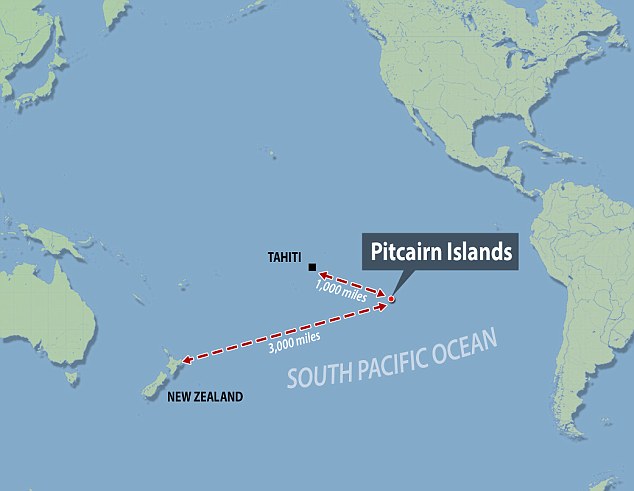Pitcairn Island
PITCAIRN (18.1 square mi or 47 square km) is an isolated island located in the east-central PACIFIC OCEAN, approximately 400 mi (644 km) southeast of Mangareva, the closest inhabited island. Pitcairn is the only inhabited island of the British colony of Pitcairn, Henderson, Ducie, and Oeno Islands. The three outer islands of the Pitcairn Islands lie to the north and northeast of Pitcairn. The island of Pitcairn itself is approximately 2 mi (3.2 km) long and 1 mile (1.6 km) wide. Pitcairn has no airstrip and no docking facilities.
The island is fringed with high cliffs, with only one small landing place, Bounty Bay near Adamstown, where longboats can be launched to intercept passing freighters and cruise ships. Communication with the outside world is by radiotelephone and e-mail. Pitcairn's climate is subtropical, tempered by southeast trade winds with occasional typhoons during the November-to-March rainy season. The volcanic soils are fertile, supporting subsistence crops of sweet potatoes, sugarcane, oranges, and bananas. The original forest cover has been much reduced because of the clearing of land for cultivation and the use of wood for handicrafts and construction.

Pitcairn Island was settled by Polynesians sometime before the 15th century. Stone tools and other carvings of Polynesian design have been found on the island, but by the 18th century the Polynesian colony had vanished. Pitcairn was discovered by Europeans in 1767 when British captain Philip Carteret passed by but was unable to land. Carteret named the island after Robert Pitcairn, the midshipman who first sighted the island. Robert Pitcairn was the son of Major John Pitcairn, British commander at the Battle of Lexington.
In 1790, Pitcairn was settled by refugees from the famed mutiny on HMS Bounty. Nine mutineers, along with 6 Tahitian men and 12 Tahitian women, settled on the island. Immediately following the mutiny, Fletcher Christian, the leader of the mutineers, had set sail for TAHITI where some of the mutineers elected to stay. Christian, however, rightly reasoned that the British Navy would send ships to look for the Bounty's crew in Tahiti, where the expedition had been sent to gather breadfruit trees for introduction into the British West Indies as a cheap food for slaves. Christian remembered Pitcairn's description from Carteret's writings and, guessing correctly that Carteret had misjudged the island's longitude, set out to find the island. Christian's small colony soon degenerated into violence, with most of the male settlers, English and Tahitian, being killed in fights over the Tahitian women.
When Pitcairn was rediscovered by an American whaler in 1808, only one of the original mutineers was left alive. This mutineer, John Adams, died in 1829, and in 1831 the colony's entire population was removed to Tahiti. Most soon returned to Pitcairn. In 1856, again because of overpopulation, the entire population was resettled on Norfolk Island, between AUSTRALIA and NEW ZEALAND, but many soon returned to Pitcairn. In 1887 the entire population of Pitcairn joined the Seventh-Day Adventist Church. The peak population of 233 was reached in 1937. Because of out-migration, mostly to New Zealand, the population of Pitcairn has been declining ever since. In 2004, seven Pitcairn men, including the island's mayor, a descendent of Fletcher Christian, were convicted of rape and child sexual abuse charges in a divisive and emotional trial conducted by judges imported from New Zealand. Even though some are once again urging the abandonment of the island, Pitcairn remains Britain's sole remaining colonial possession in the Pacific.